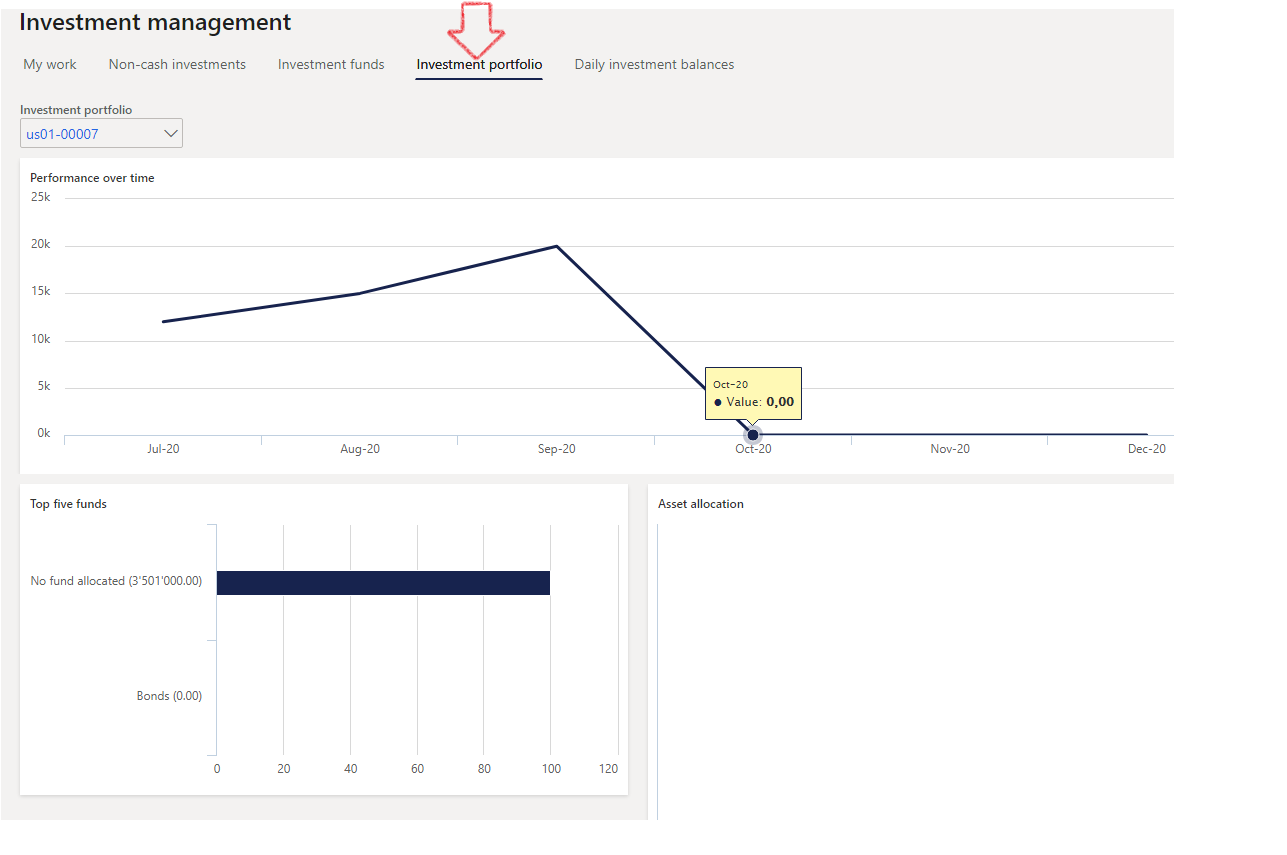¶ Introduction
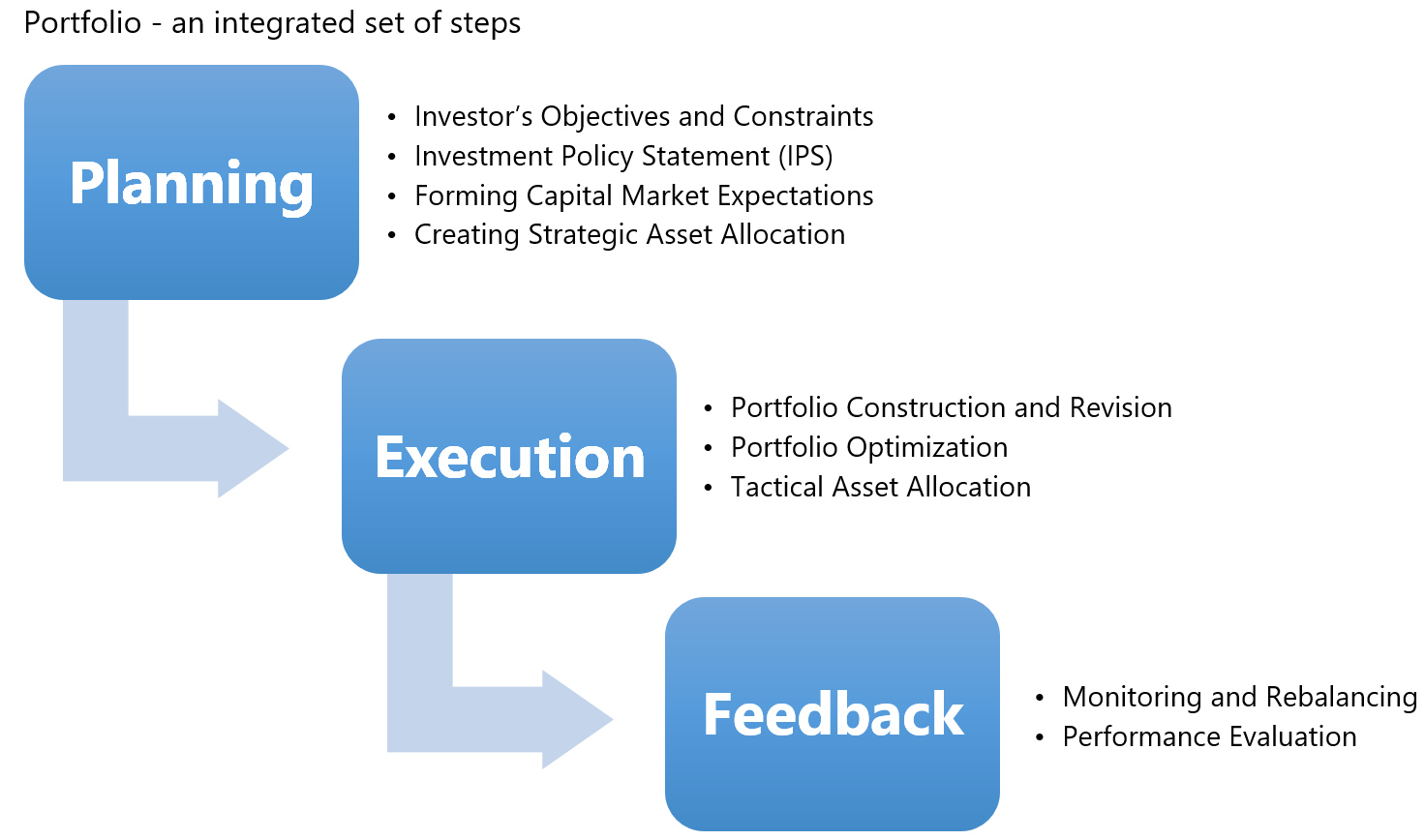
Investment management involves the oversight of financial securities and assets, including strategies for acquiring, disposing of, and growing investment portfolios. Portfolios can include both cash and non-cash investments, and may be actively traded to achieve specific investment objectives.
Diversification of portfolios often combines cash and non-cash investments. The Treasury Management System (TMS) also supports cryptocurrency investments and management of nominated beneficiaries.

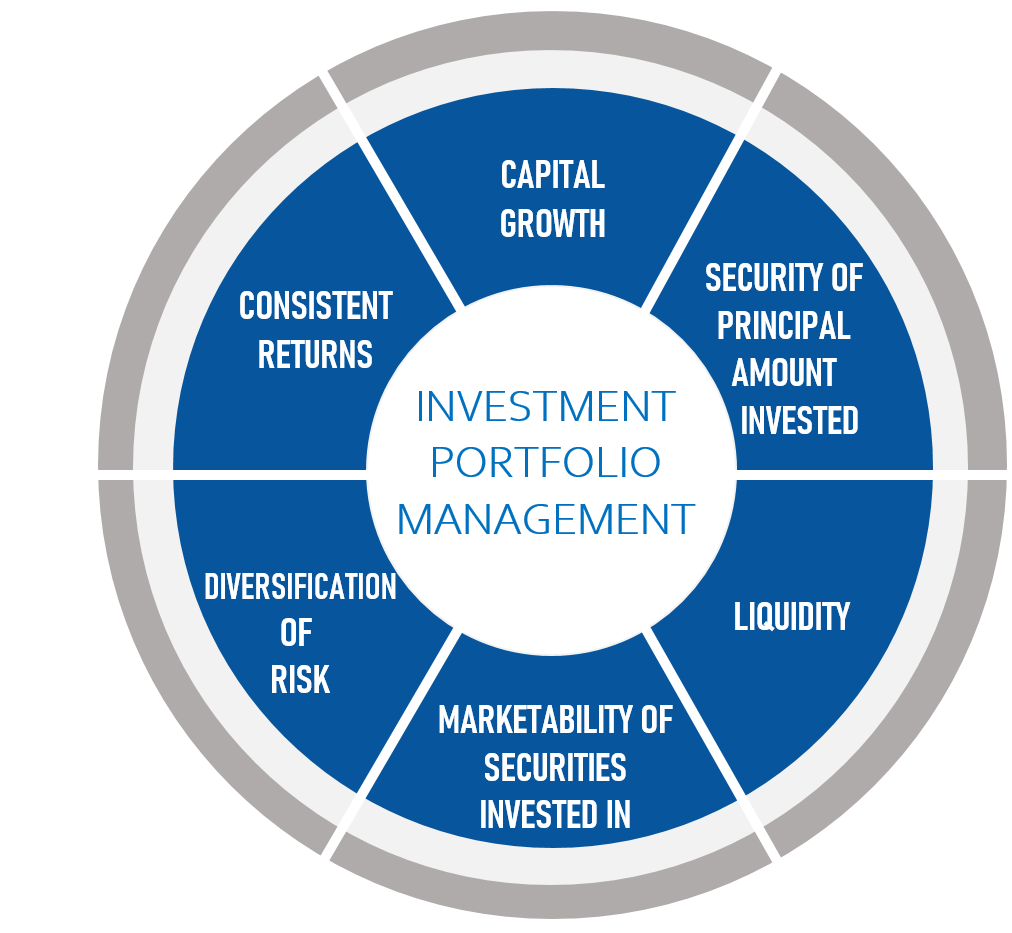
¶ Objectives of portfolio management
- Establishing the investment objectives
- Diversifying the portfolio to reduce risk and maximize returns
- Monitoring the performance of the portfolio and taking corrective action when necessary
- Rebalancing the portfolio in order to maintain the desired level of risk and return
- Tax planning and implications
- Asset allocation to determine the desired level of return and risk
¶ Navigation
Inside Microsoft Dynamics 365, Axnosis created a storage area for Investments Portfolio management . From the main menu, browse to Treasury, Investments, Investment portfolio
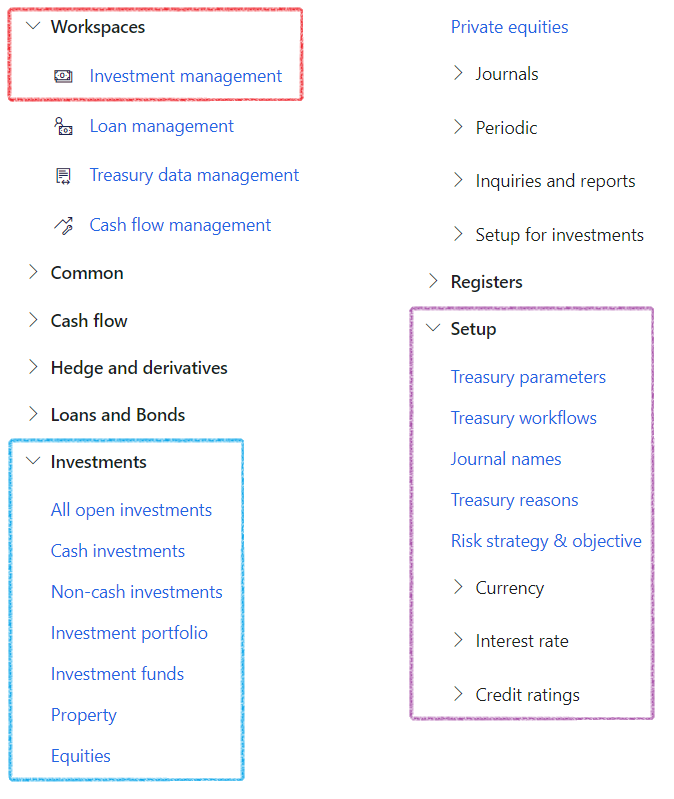
¶ Assumed Setup
The following configurations are considered completed already:
- Number sequence
- User roles
- Treasury workflows
- Customers
- Vendors
- Cash investments
- Non-Cash investments
- Treasury parameters
- Risk profile
¶ Daily use
¶ Step 1: Create a new Investment portfolio
The portfolio management list page will provide an overview of the portfolios’ overall situation, so that the investment strategy is devised using all available information - Its valuation, performance and relation to individual benchmarks.
The following columns will be displayed on the list page:
- Investment portfolio number
- Description
- Status
- Risk profile
- Customer account
- Inception date
- Valuation date
- Last valuation
- Currency
- Underwritten by

- Navigate to: Treasury > Investments > Investment portfolio
- Click on New
The Investment portfolio number is system generated
- Type a Description
- Select a Risk profile from the dropdown menu.
- Options to choose from:
- Select a Risk profile from the dropdown menu.
- Options to choose from:
- Very aggressive
- Aggressive
- Moderately aggressive
- Moderate
- Conservative
- Risk averse
- Options to choose from:
- Select a Customer account from the dropdown menu
- Enter an Inception date
- Enter a Currency
- Click OK
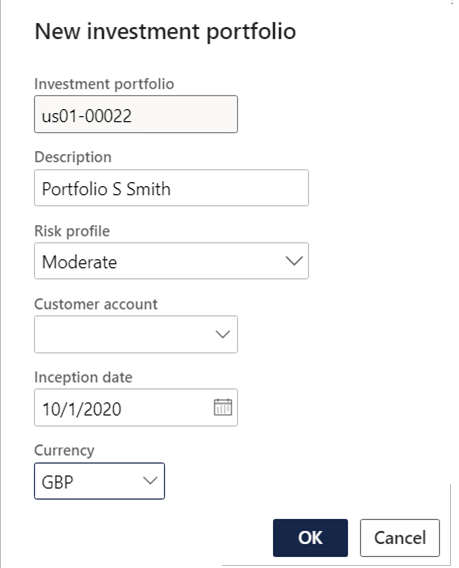
- The details page is divided into the following FastTabs:
- General
- Ratios
- Performance
- Linked investments – cash
- Linked investments - other
- Nominated beneficiary details
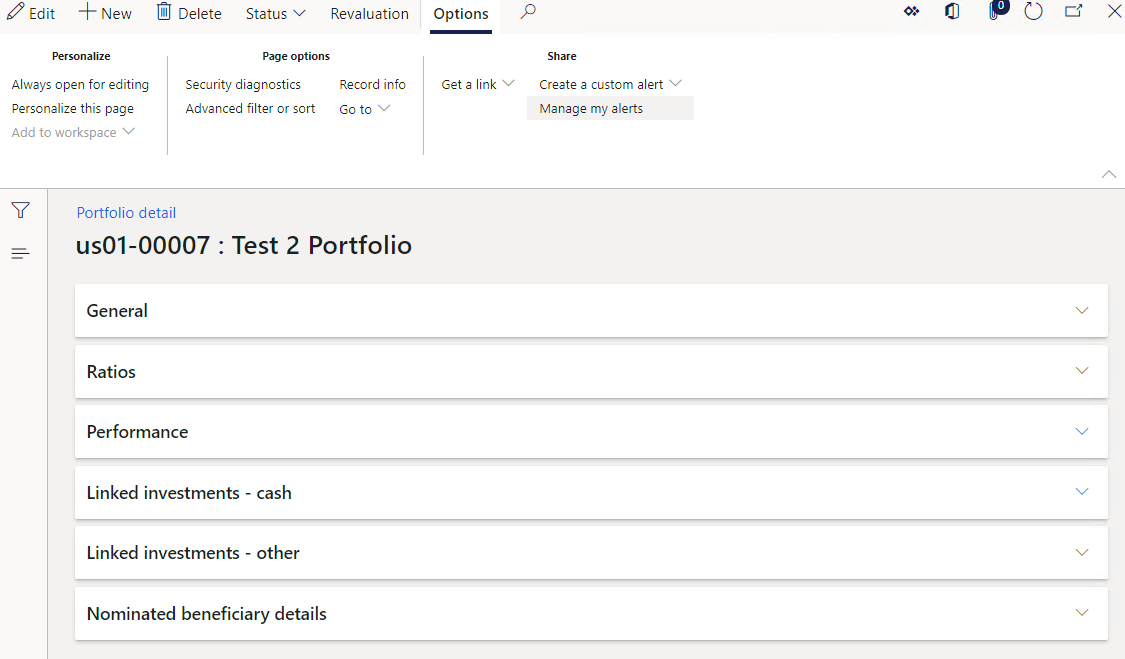
¶ Step 1.1: General FastTab
The General FastTab consists of the following sections:
- Overview
- Investment portfolio number
- Description
- Status
- Risk profile
- Customer account
- Currency
- Underwritten by
- Detail
- Inception date
- Realisation date
- Termination date
- Valuations
- Last valuation
- Amount
- Valuation date
- Currency
- Last valuation
- Additional
- Duration
- Days
- Duration
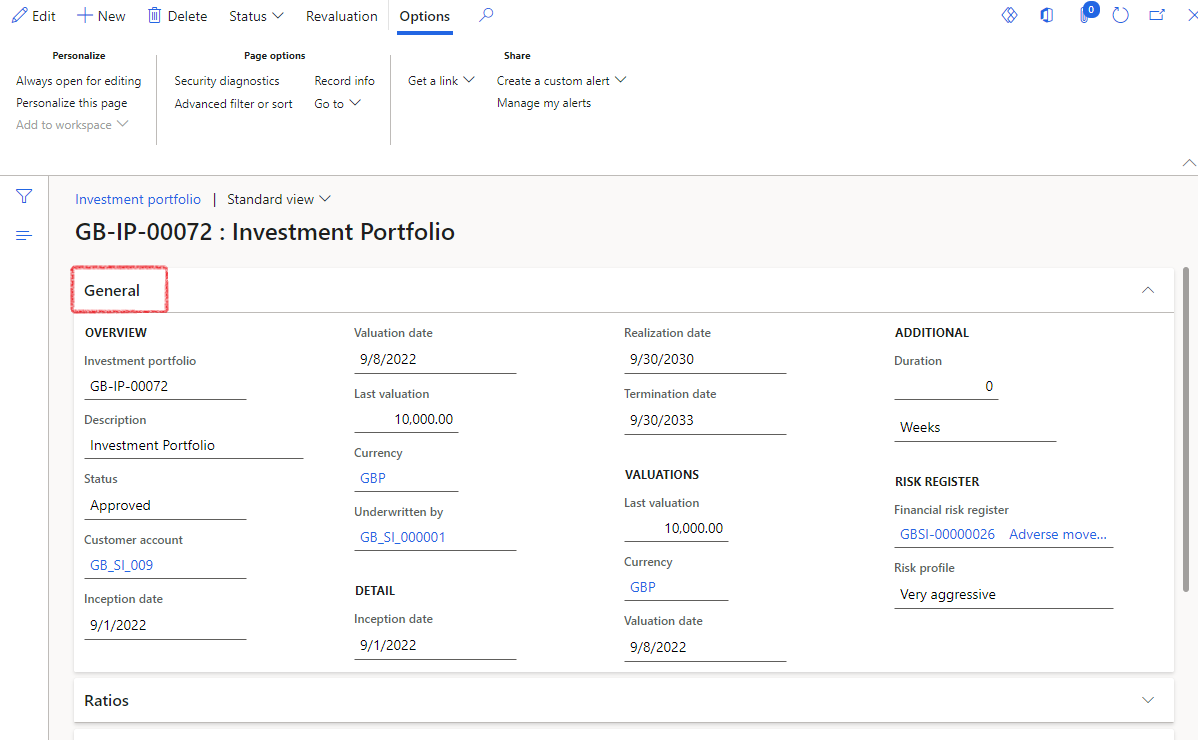
¶ Step 1.2: Ratios FastTab
Fields on the Ratios FastTab:
- Date
- Enter a date
- IRR
- Internal Rate of Return
- TER
- The total expense ratio
- Alpha
- The Alpha is the difference between what an asset returned and what its benchmark returned
- Beta
- Beta (β) is a measure of the volatility—or systematic risk—of a security or portfolio compared to the market as a whole
- Correlation
- Correlation, in the finance and investment industries, is a statistic that measures the degree to which two securities move in relation to each other.
- Correlations are used in advanced portfolio management, computed as the correlation coefficient, which has a value that must fall between -1.0 and +1.0
- R-Squared
- R-squared measures the relationship between a portfolio and its benchmark index. It is expressed as a percentage from 1 to 100.
- R-squared is not a measure of the performance of a portfolio. Rather, it measures the correlation of the portfolio's returns to the benchmark's returns.
- Sharpe ratio (Sharpe index)
- The Sharpe ratio is a way to measure the performance of an investment by taking risk into account. It can be used to evaluate a single security or an entire investment portfolio.
- The Sharpe ratio is a measure of return often used to compare the performance of investment managers by making an adjustment for risk.
- The Sharpe Ratio is the difference between the risk-free return and the return of an investment divided by the investment's standard deviation. The Sharpe Ratio adjusts the performance for the excess risk taken by an investor.
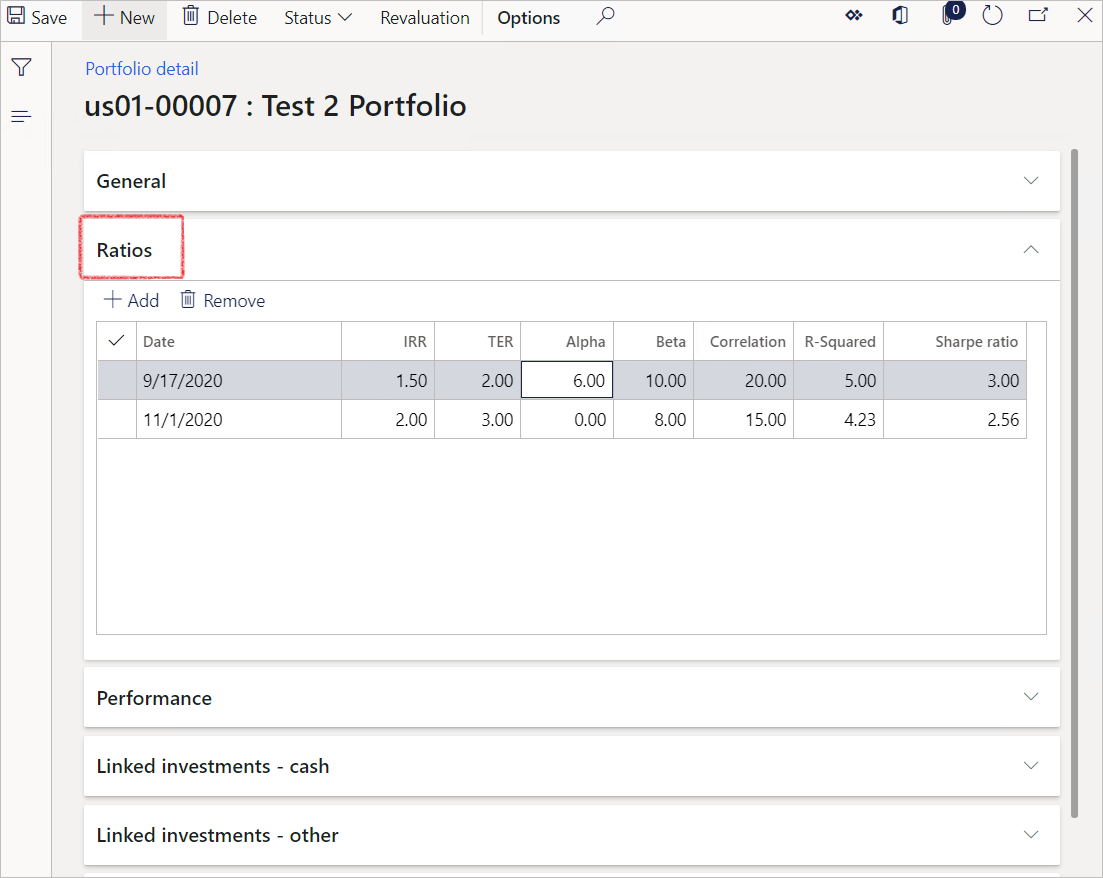
¶ Step 1.3: Performance FastTab
Expand the Performance FastTab and enter the necessary data:
- Enter a date
- Enter the Opening amount
- Enter the Movement
- Enter a Closing amount
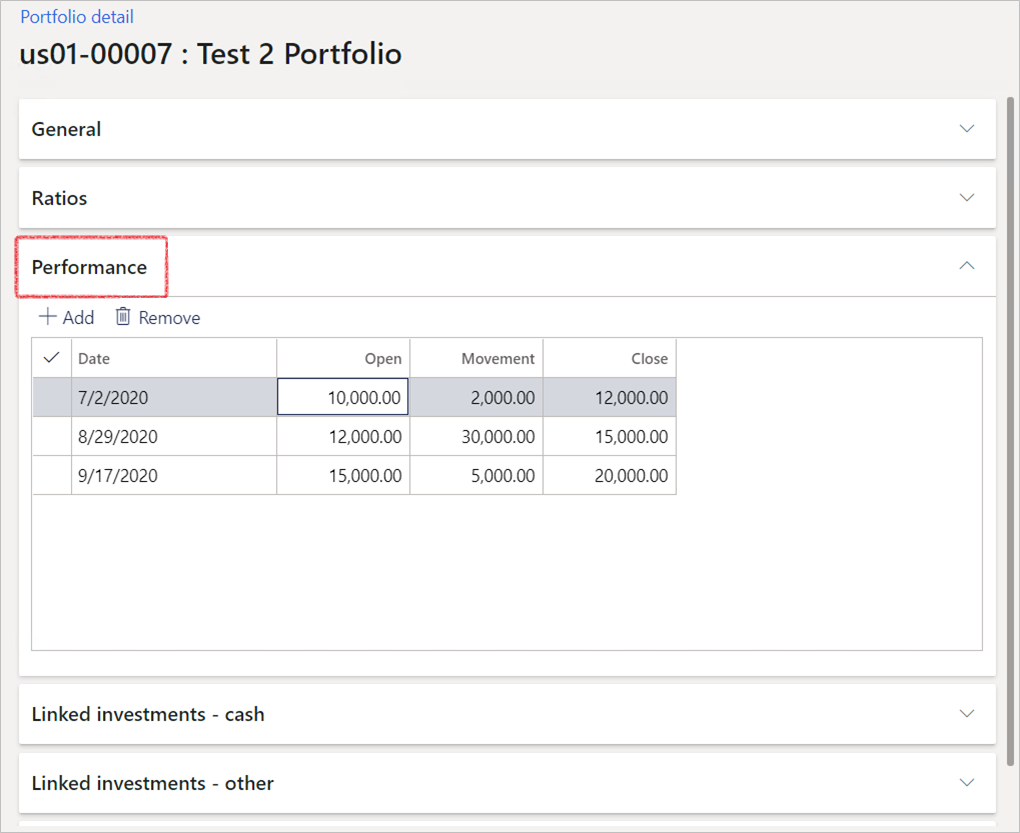
¶ Step 1.4: Linked investments – Cash FastTab
The following fields will be automatically filled out when adding an investment to a Portfolio record by utilizing the data from the chosen record:
- Cash investments
- Bank account
- Account type
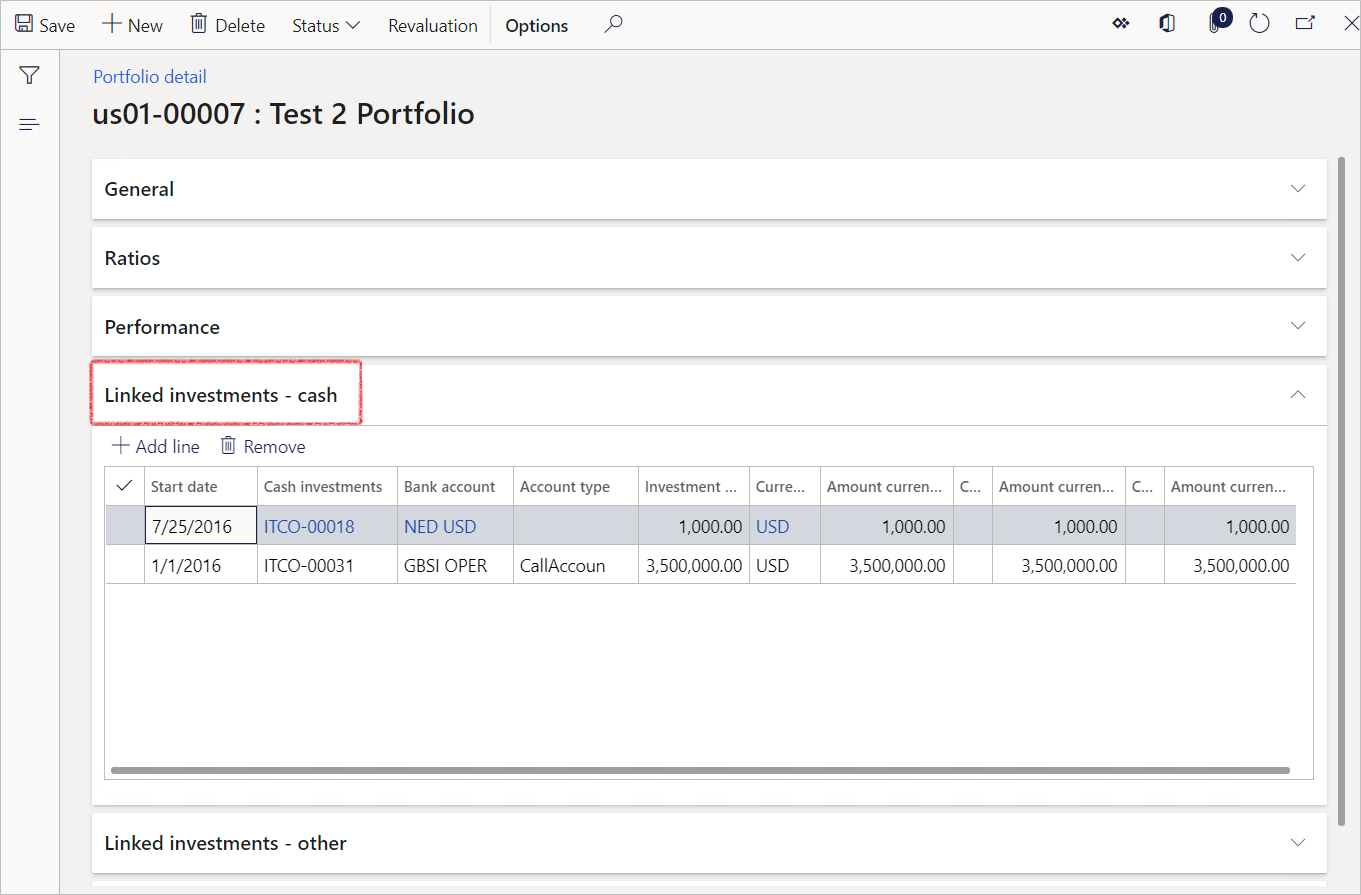
¶ Step 1.5: Linked investments - other FastTab
- A non-cash investment can be chosen from the dropdown menu.
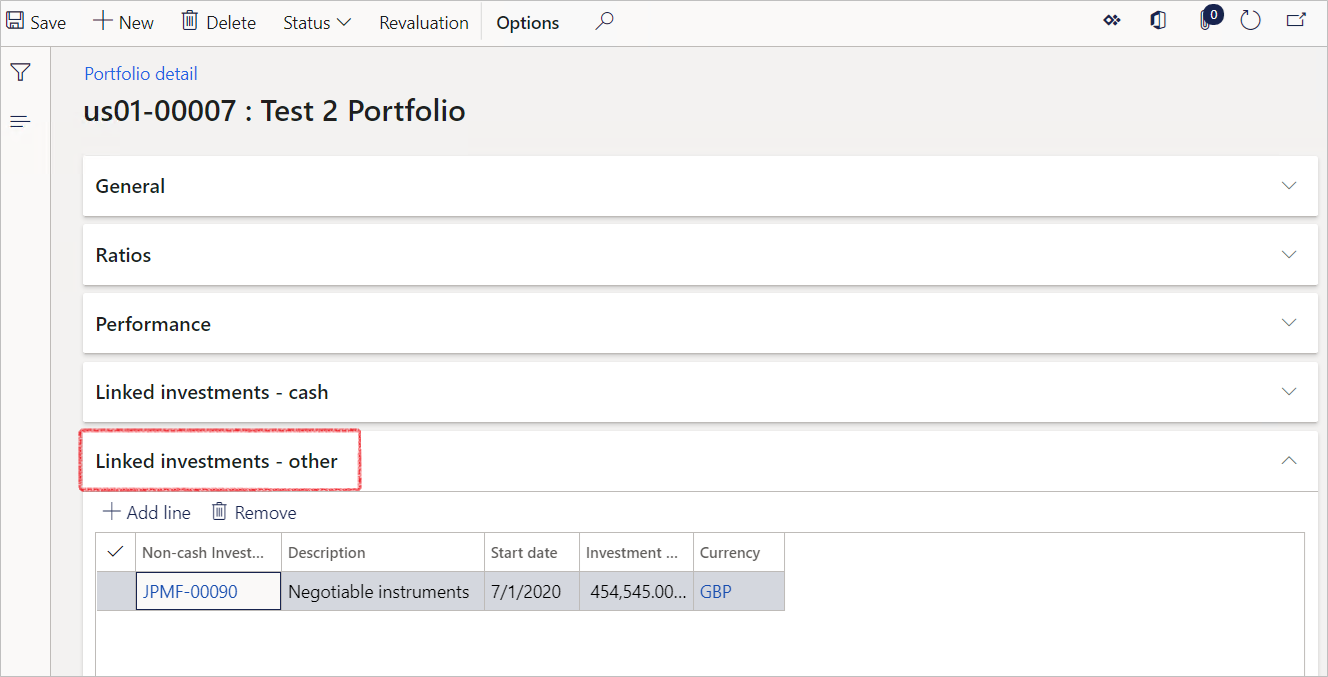
A single Investment cannot be connected to more than one Portfolio or Loan
One portfolio may be linked to a number of investments (both Cash- and Non-Cash investments)
¶
Step 1.6: Nominated beneficiary details FastTab
- Expand the Nominated beneficiary details FastTab
- Click on Add to add a new line
- The Beneficiary ID is system generated
- Enter a Name
- Enter a Surname
- Select the Relationship. Choose between
- Father
- Mother
- Grandfather
- Grandmother
- Child
- Brother
- Sister
- Friend or
- Other
- Enter a From date
- Enter a To date
- Choose between Percentage or Amount
- Enter a Value
- Select a Currency
- Type an Email address
- Enter a Telephone number
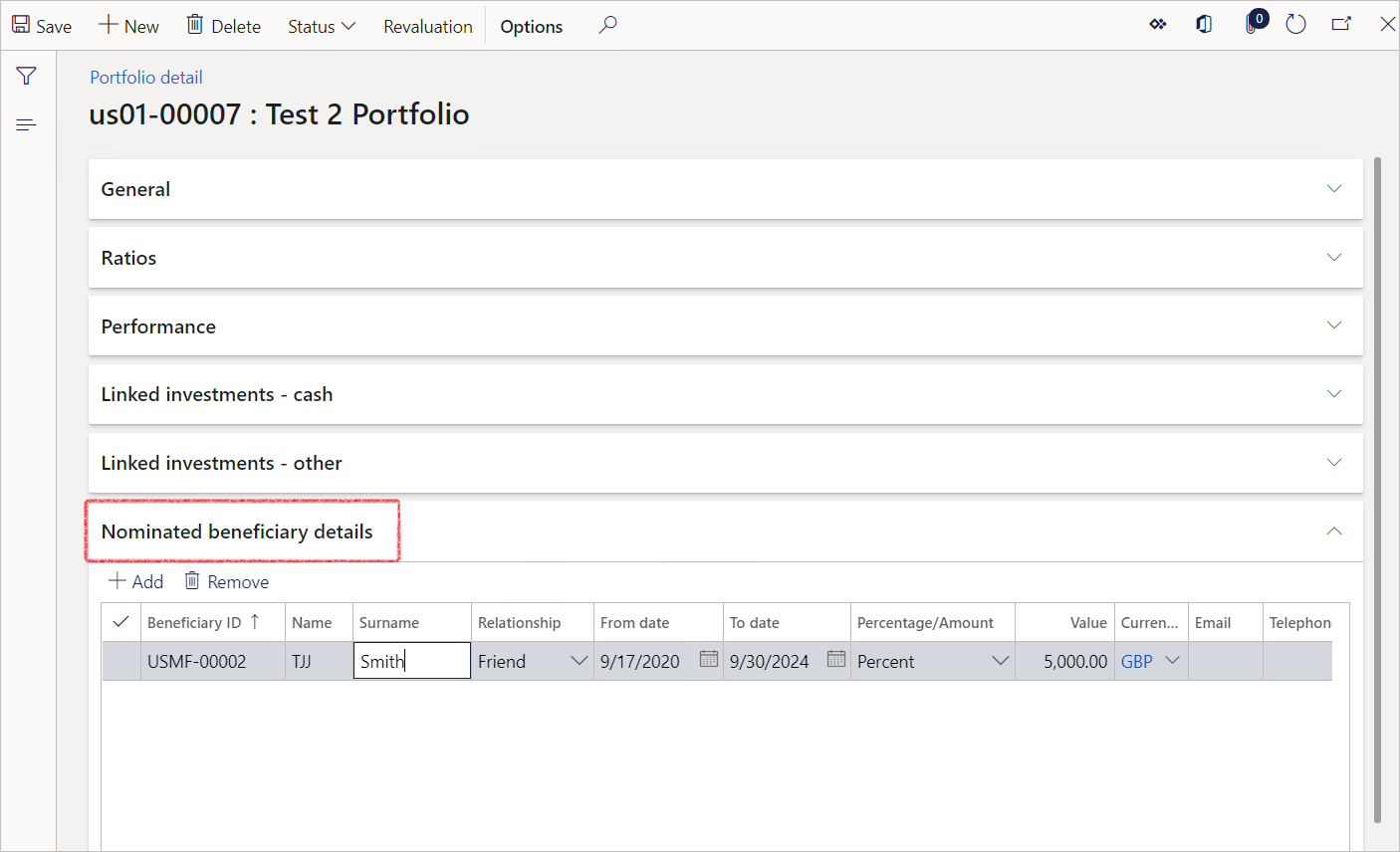
¶ Step 2: Status
The Status of an Investment portfolio can be set to:
- Approved
- Cancelled
- Proposed
- None
These statuses can be used in conjunction with Workflows.
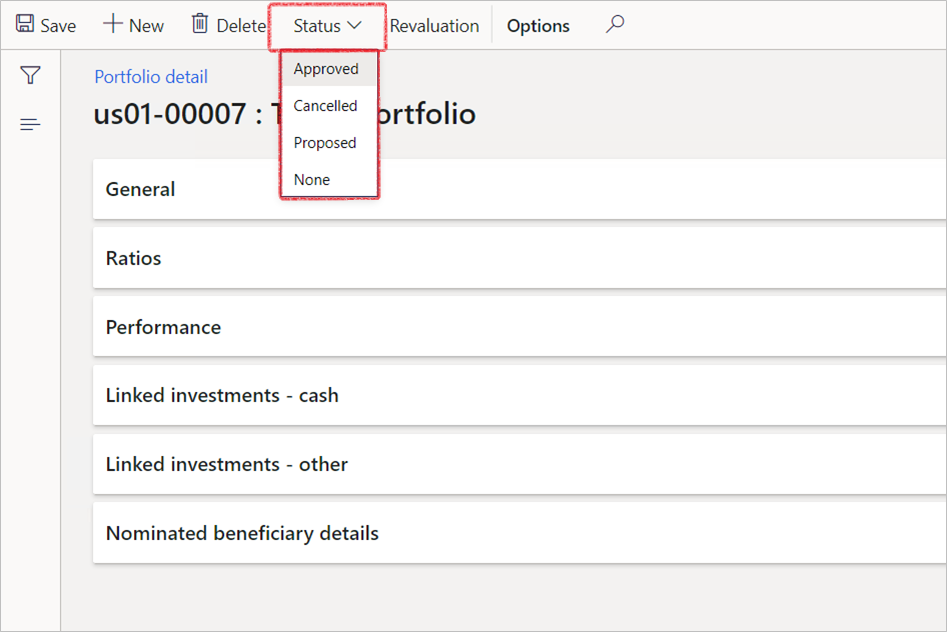
¶ Step 3: Investment portfolio Workspace
The portfolio management Workspace will provide an overview of the portfolios’ overall situation, so that the investment strategy is devised using all available information - Its valuation, performance and relation to individual benchmarks.
The list page will show the Investment portfolio number, Description, Status, Risk profile, Inception date, Valuation date, Currency and Customers or Vendors.
- Navigate to: Treasury > Investments > Investment portfolio
- Click on the Investment portfolio tab on top
- This page is divided into three sections:
- Performance over time
- Top five funds and
- Asset allocation
